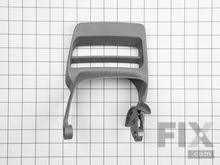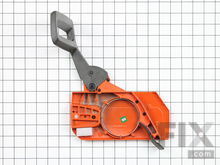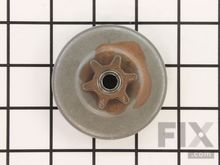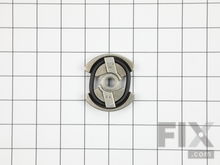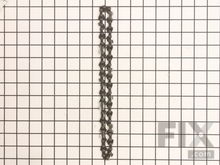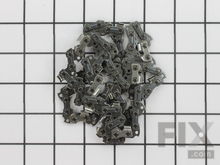How To Repair Chainsaw Chain
- Rated as REALLY EASY
- 6 step by step videos
Engine
If the chain does not stop rotating when the throttle is released, it is likely that the engine is set to idle at too fast of a speed. The clutch uses centrifugal force to engage the chains, meaning that the crankshaft will spin inside of the clutch without the clutch catching and starting to spin as well, until a certain amount of speed is achieved. Once a certain speed is reached, the clutch engages and forces the chain to rotate. When the throttle is not engaged, the engine should idle at a slow enough speed so that the clutch does not engage and start driving the chain. If the chain is rotating when the engine is idling, adjust the carburetor on your engine to slow down the idle speed. Refer to your user manual for specific instructions on how to adjust the idle speed
Chain Brake Set
The chain brake is a safety mechanism present in all chainsaws (unless they are much older models) designed to stop the chain from rotating around the bar. This brake can be engaged by hand, by pushing the chain brake handle forward, or by inertia when the saw kicks back. If the engine is running but the chain brake is set, the chain will not rotate. To disengage the chain brake, pull back on the chain brake handle to release the chain. Once the engine is revved, the chain should begin to rotate around the bar. If the brake handle will not disengage or the chain does not rotate, the chain brake may be stuck.
Chain Brake
If you disengage your chain brake but the saw blade will not rotate, it is likely that the chain brake mechanism is locked or broken and still holding the blade, even though the brake handle is in the ‘off’ position. The chain brake can lock if the clutch cover is removed while the brake is engaged. Always remember to disengage the chain brake before removing the cover. Failing to do so can result in difficulty replacing the clutch cover, and difficulty disengaging the chain brake once the cover has been replaced. This is a common mistake and can be fixed easily by resetting the chain brake. This is done by keeping the brake handle in the engaged position, and reinstalling the clutch cover. This may take some force to do, as it is meant only to come on and off with the brake disengaged. Once the cover is replaced, pull the chain brake handle back to release the brake. An audible crack should be heard from the mechanism disengaging. Once the brake is disengaged, the clutch cover should be much easier to remove.
Clutch
There may be a problem with the clutch if the chain will not turn while the engine is running normally. The clutch is attached to the crankshaft, and engages the chain to start rotating once a certain rotational speed is reached. The clutch allows the engine to run without always rotating the chain. When the engine is revved up, the clutch engages the sprocket and forces the chain to turn. If the clutch is broken or the springs are not tensioned properly, the clutch may not engage at all. A broken clutch is easy to replace once you remove the side cover; the same cover that secures the chain. When removing the spark plug, feed a piece of scrap starter rope into the combustion chamber to stop the piston from moving while the clutch is removed. Refer to your user manual for the proper replacement part number if your clutch is broken.
Chain
If your chainsaw blade will not rotate, the chain may be tensioned too tight. When the chainsaw is cold (has not been run recently), the chain should sit on the bar fairly snugly, and raise around ¼- ½ an inch off of the bar if pulled. If the chain is too tight, the blade may not spin when the throttle is engaged, which can cause damage to the clutch or other associated parts. Keep in mind that the tension of the chain will change with heat. As the chainsaw is used and the chain heats up, it will become loose. If you are using the chainsaw for an extended period of time, it is a good idea to stop every 20-30 mins to check and adjust the chain tension, if necessary.
Guide Bar
The chainsaws guide bar keeps the chain in place as it rotates. The bar should stop the chain from wobbling back and forth, which keeps the chain moving in a perfectly straight rotation. If the bar is damaged and the chain is allowed to wobble, the efficiency of the saw will diminish as the blade will not cut as consistently as it normally would. Refer to your user manual for information on how to maintain both the chain and the bar, and for instructions on how to repair or replace a damaged bar.
More Repair Parts
Still not sure which part is broken? We can offer you custom troubleshooting help if you search with your model number.








